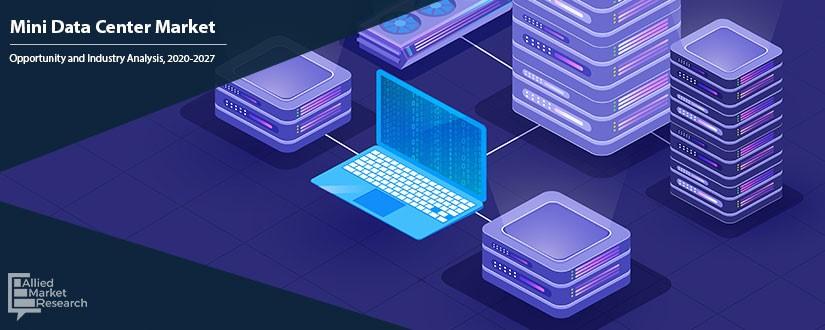Mini Data Center Market Statistics: 2027
A mini data center is a smaller size data center architecture, which is a portable data center usually a container with pre-loaded racks, servers, cooling, and power. The size of mini data center varies from rack to container, a mini data center includes fewer than four servers in a single 19-inch rack. It comes with inbuilt security systems, cooling systems, and fire protection. Generally, there are separate rack-level systems containing all elements of a traditional data center, comprising in-rack cooling, power backup, power supply, and security. Mini data center is an important evolution in the industry, which helps organizations in managing their data at a low cost within limited space. Mini data centers are cost effective, compact, flexible, and require less deployment time, thus easing data handling for enterprises.
COVID-19 Scenario Analysis:
- Advent of COVID-19 has disrupted data center transformation. However, there is a growth in data traffic, owing to initiatives such as work from home and lockdown, which propels data center services such as VON services, video gaming, cloud computing, internet exchanges, content delivery networks, and other online services. This has compelled data center companies to improve their infrastructure, which, in turn, is anticipated to drive the market growth
- With the help of hyperscale data center web services, numerous companies are applying algorithms for industry specific models that can recognize, classify, and analyze relationships in the data and can be used to recommend content, tag photos, and deliver relevant advertising.
Top impacting factors: Market Scenario Analysis, Trends, Drivers, and Impact Analysis
Growth in demand for edge computing and cost effective and easily portable solutions, coupled with increase in demand for standardized infrastructure for organizations are major factors that drive the mini data center market growth.
However, vendor lock-in situations can hamper the growth of market to a certain extent. Contrarily, growing demand for hybrid cloud infrastructure among various industries and increase in digital traffic are the opportunity factors of the mini data center market.
Growth in demand for edge computing
Edge computing is an architectural model in which information generated by loT devices is processed at the edge of a network, which is generally close to the source of data. The number of internet-connected devices can reach an estimated 30 billion by 2020, which is expected to give a significant boost to the global mini data center market. The use of RFID sensors to track, tag, connect, and read objects in warehouses and logistics promotes the concept of loT. Increase in number of connected devices result in generation of large volumes of data.
Meanwhile, concepts such as a connected home, connected health, connected car, and smart cities are becoming increasingly popular. Many industries such as utilities, retail, manufacturing, automotive, and social media are using IoT for increased data transfer. By the end of 2020, IoT-enabled devices are expected to enhance data center traffic. This rise in number of IoT-enabled devices would trigger the need for edge computing facilities. Therefore, rise in need for edge computing is expected to be one of the major trends that would boost the mini data center market during the forecast period.
Vendor lock-in limits buying options
One of the major disadvantages of mini data center is the inherent dependency on providers, which is known as “vendor lock-in.” It is difficult to migrate from a provider if a user wishes to switch as it gets very difficult to transfer huge amount of data from one provider to another. When a business completely depends on a service provider to handle data center, then organizations are unable to use any other vendor, without experiencing monetary loss. This is a major reason why businesses carefully contemplate all options while picking a vendor. Consequently, it is always wise to guarantee that a contract does not constrain from using the same vendor to an extended amount of time and that their proprietary services have suitable replacements in other places. Thus, vendor lock-in is a tedious situation which can hinder the market growth to a certain extent.
Key benefits of the report:
- This study presents analytical depiction of the global mini data center industry along with the current trends and future estimations to determine the imminent investment pockets.
- The report presents information related to key drivers, restraints, and opportunities along with detailed analysis of the global mini data center market share.
- The current mini data center market is quantitatively analyzed to highlight the global mini data center market growth scenario.
- Porter’s five forces analysis illustrates the potency of buyers & suppliers in the mini data center market.
- The report provides a detailed mini data center market analysis based on the present and future competitive intensity of the market.
Mini Data Center Market Report Highlights
| Aspects | Details |
| By Solution |
|
| By Organization Size |
|
| By Rack Unit |
|
| By Application |
|
| By Industry Vertical |
|
| By Region |
|
| Key Market Players | Eaton Corporation Plc, Vertiv Group Corp., Rittal GmbH & Co.KG, Canovate Group, Hewlett Packard Enterprise Co, Legrand SA, Rahi Systems, Scale Matrix Holding Inc, Inspur Group, Schneider Electric SE |
Loading Table Of Content...



